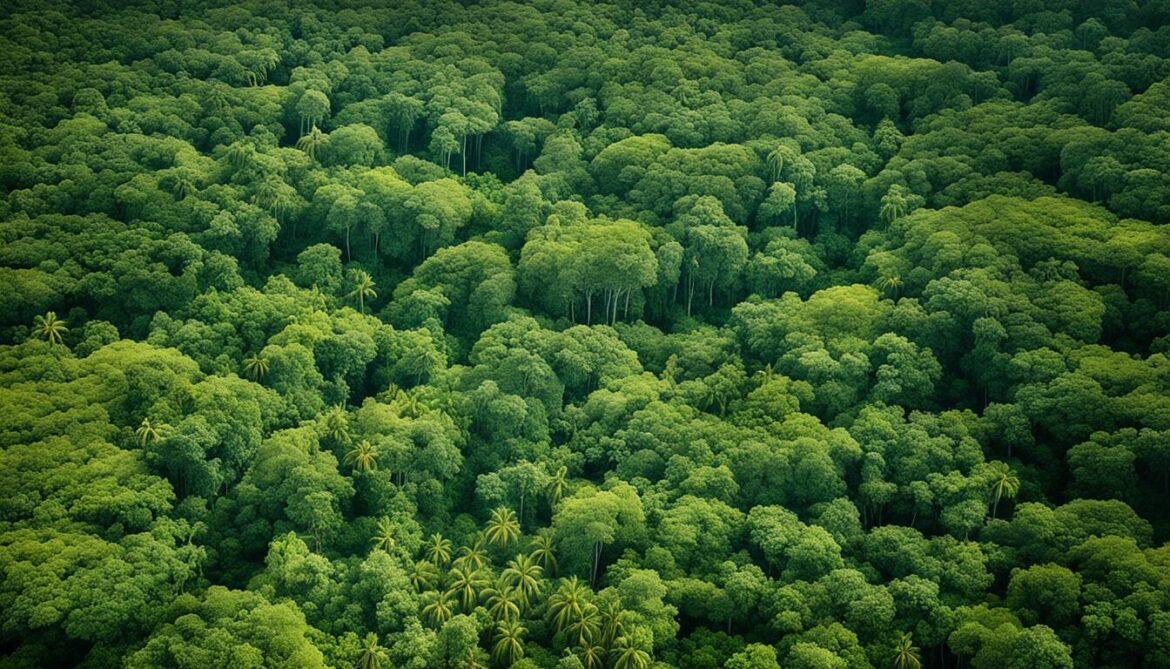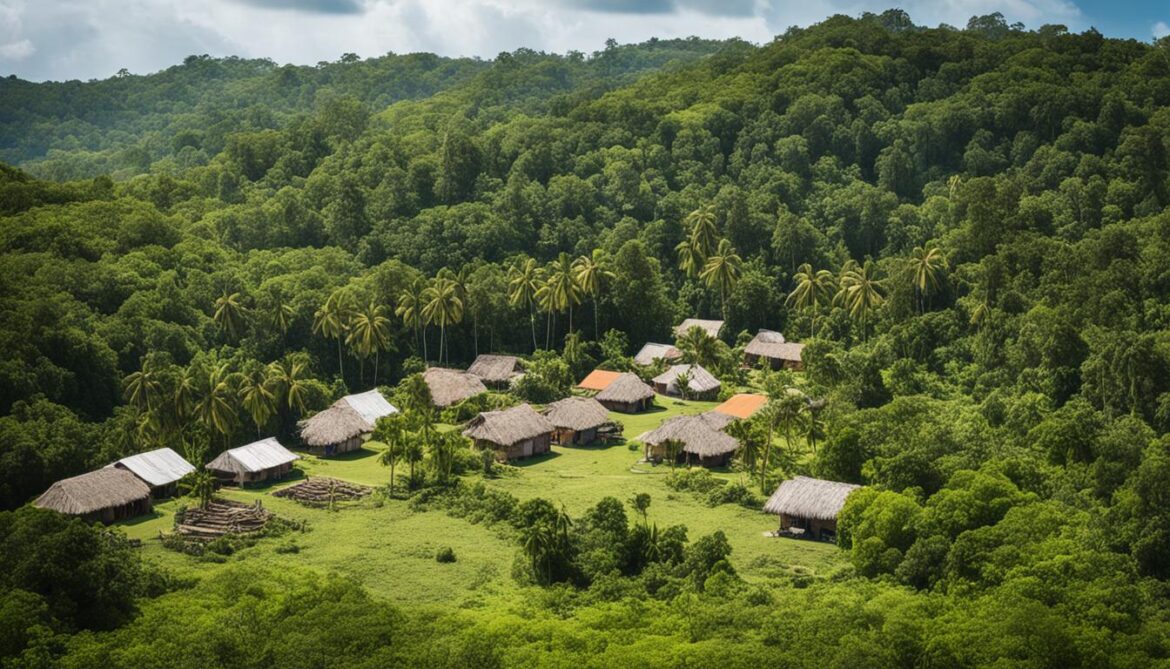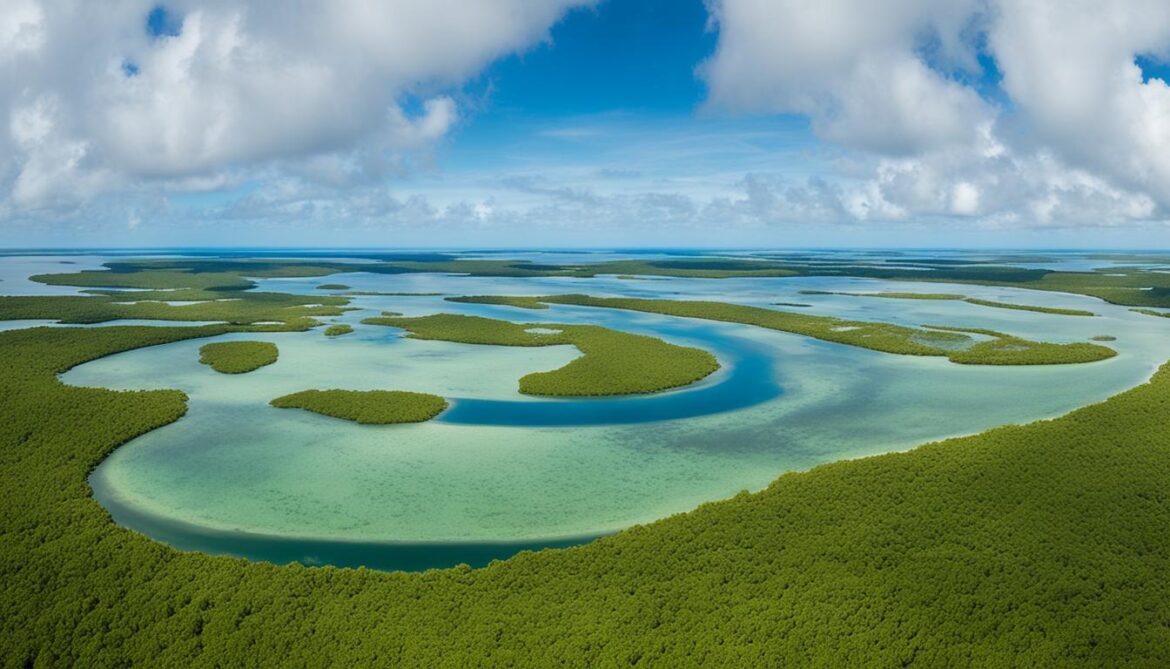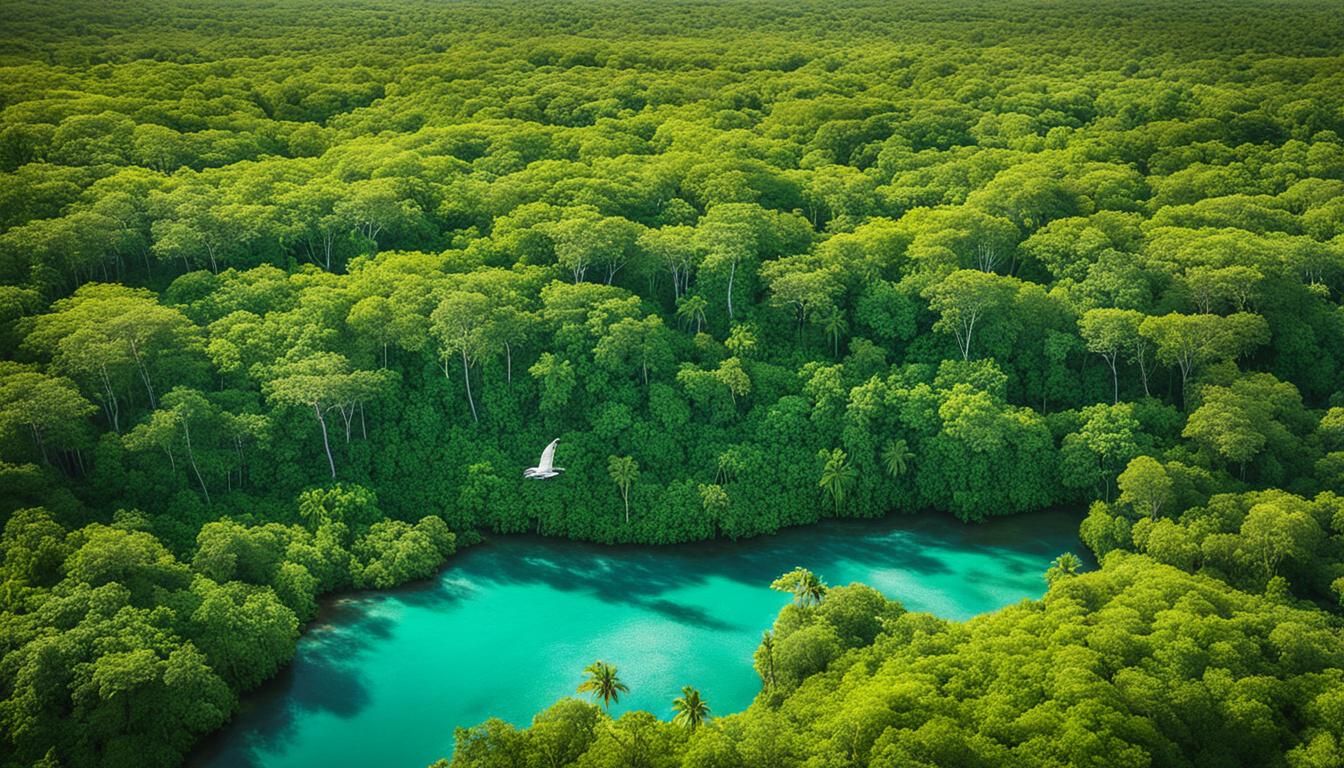Did you know that Belize is home to a staggering diversity of flora and fauna? In fact, this small Central American country boasts an incredible 9% coverage of protected areas, safeguarding its sacred natural sites and extraordinary biodiversity. The pristine Belize Maya Forest, recently protected from deforestation, is a haven for iconic species like jaguars and tapirs. But that’s just the beginning. Let’s explore how Belize’s commitment to conservation and sustainable development is paving the way for a greener future.
Key Takeaways:
- Belize is home to a diverse range of flora and fauna, thanks to its extensive network of protected areas.
- The Belize Maya Forest, recently safeguarded from deforestation, is a vital habitat for iconic species such as jaguars and tapirs.
- The government of Belize has implemented measures to ban activities like oil drilling, prioritizing the protection of its natural resources.
- Efforts are being made to involve local communities in conservation action plans, promoting sustainable practices like low-impact eco-tourism and sustainable agriculture.
- Belize’s commitment to protecting its coastal wetlands demonstrates its recognition of the importance of these habitats for both biodiversity and climate change mitigation.
Saving Belize’s Pristine Rainforests
The recent acquisition of the Belize Maya Forest by a coalition of conservation organizations is a significant step towards protecting Belize’s pristine rainforests. This protected area, along with other protected areas in Belize, contributes to the country’s efforts in environmental preservation. The government of Belize has made conscious decisions to ban activities like oil drilling in order to safeguard its natural resources and promote sustainable development.
Belize is committed to preserving its natural heritage and ensuring the long-term conservation of its ecosystems. By designating and protecting various areas as belize protected areas, the country takes proactive measures to maintain the ecological balance and biodiversity of its rainforests.
The Belize Maya Forest, in particular, holds immense value for both its environmental significance and cultural heritage. This expansive rainforest, covering a vast landmass, is now shielded from deforestation and degradation, thanks to the collaborative efforts of conservation organizations.
“The protection of Belize’s rainforests is a testament to the dedication and commitment of the country and its partners in preserving our planet’s natural wonders,” says Dr. Maria Hernandez, an environmental scientist and advocate for belize environmental preservation.
The Belize Maya Forest, alongside other belize protected areas, acts as a critical habitat for a diverse range of flora and fauna. This includes iconic species like the jaguar and tapir, which thrive in the rich biodiversity of these rainforests.
By banning activities such as oil drilling, the government of Belize demonstrates its commitment to belize environmental preservation. These conscious decisions safeguard the country’s natural resources and promote sustainable development practices that prioritize the well-being of both the environment and its inhabitants. Belize serves as an inspiring example for other nations in promoting a harmonious relationship between economic growth and ecological preservation.
Belize’s Protected Areas
| Protected Area |
Size (km²) |
Biodiversity |
| Belize Maya Forest |
X,XXX |
Diverse range of flora and fauna, including jaguars, tapirs, and numerous bird species |
| Rio Bravo Reserve |
X,XXX |
Important wildlife corridor, home to diverse plant and animal species |
| Cockscomb Basin Wildlife Sanctuary |
XXX |
World’s first jaguar reserve, protects a variety of tropical habitats |
| Hol Chan Marine Reserve |
XX |
Thriving coral reef ecosystem, abundant marine life |
The belize protected areas not only serve as havens for wildlife but also offer opportunities for eco-tourism and education. Visitors can explore these natural wonders while learning about the importance of conservation and sustainable practices. It is through these initiatives that Belize aims to inspire a deeper appreciation for the environment and encourage active participation in belize environmental preservation.
Preserving Belize’s Biodiversity
Belize’s biodiverse ecosystems are a source of pride and importance for the country. The Maya Forest and other protected areas in Belize are home to a wide variety of flora and fauna species. The rich flora and fauna diversity found in these areas contributes to the overall health and balance of the region’s ecosystems.
Indigenous communities in Belize play a crucial role in preserving the biodiversity of these areas. Their conservation practices, rooted in traditional knowledge and sustainable practices, help maintain the delicate balance of the natural environment. Through their intimate connection with the land, indigenous communities have a deep understanding of the ecological processes and the importance of protecting and preserving the unique biodiversity of Belize.
Involving local communities in conservation action plans is a key strategy for protecting and preserving Belize’s biodiversity. By engaging indigenous communities in decision-making processes and empowering them to participate in conservation efforts, there is a greater chance of success in ensuring the long-term sustainability of the region’s ecosystems.
Conservation action plans in Belize often include initiatives that promote low-impact eco-tourism and sustainable agriculture. These approaches not only generate income but also contribute to the preservation of the biodiversity of the region. Low-impact eco-tourism allows visitors to experience the natural beauty of Belize while minimizing negative impacts on the environment. Sustainable agriculture practices, such as organic farming and agroforestry, help protect the soil, water, and wildlife habitats, ensuring the long-term viability of Belize’s diverse ecosystems.
Conservation Efforts by Local Communities
Local communities in Belize are actively involved in various conservation initiatives to preserve the country’s biodiversity. Here are some examples:
- Participating in reforestation projects to restore habitats for endangered species
- Implementing sustainable fishing practices to protect marine biodiversity
- Engaging in wildlife monitoring programs to track population trends and identify conservation priorities
These efforts highlight the commitment and dedication of Belizean communities to protect and preserve their natural heritage for future generations.

The image above showcases the diverse flora and fauna of Belize, emphasizing the importance of preserving the country’s biodiversity.
| Threats to Belize’s Biodiversity |
Conservation Strategies |
| Habitat loss due to deforestation and urbanization |
Establishment of protected areas, reforestation efforts, and sustainable land-use practices |
| Illegal wildlife trade |
Enhanced law enforcement, public awareness campaigns, and community-led conservation initiatives |
| Climate change impacts |
Implementation of climate change adaptation measures and promotion of sustainable development practices |
The table above highlights the key threats to Belize’s biodiversity and the corresponding conservation strategies implemented to mitigate these threats.
Mitigating Climate Change through Forest Conservation
Forests like the Belize Maya Forest hold vast amounts of carbon and play a crucial role in mitigating the impacts of climate change. The protection of large areas of pristine rainforests, such as the Maya Forest, is an essential part of Belize’s sustainable development strategy. By preserving these forests, Belize contributes to global efforts in reversing the current trend of deforestation and reducing carbon emissions.

The Importance of Forest Conservation
The Belize Maya Forest, with its rich biodiversity and carbon-storing capabilities, serves as a natural climate solution. Forests act as carbon sinks, absorbing CO2 from the atmosphere and storing it in trees, soil, and vegetation. By protecting the Belize Maya Forest, Belize is not only preserving its natural heritage but also actively combating climate change.
Deforestation and forest degradation are major contributors to greenhouse gas emissions, accounting for nearly 10% of global CO2 emissions annually. Sustainable forest management and conservation efforts are vital to mitigating climate change and achieving sustainable development goals.
Conserving forests is not only crucial for reducing emissions but also for ensuring the maintenance of ecosystem services such as water regulation, climate regulation, and biodiversity conservation. Forests play a significant role in sustaining livelihoods and supporting local communities.
The Role of Belize in Sustainable Development
Belize’s commitment to sustainable development is evident through its proactive approach to forest conservation. The protection of large areas like the Maya Forest contributes to safeguarding natural resources, promoting eco-tourism opportunities, and fostering a resilient economy.
Belize recognizes that sustainable development cannot be achieved without addressing climate change and preserving its natural ecosystems. By valuing its forests and investing in their protection, Belize sets an example for other countries striving to balance development with environmental sustainability.
Contributing to Global Efforts
Belize’s efforts in forest conservation not only benefit the country and its residents but also contribute to global efforts in combating climate change. International frameworks, like the Paris Agreement, emphasize the importance of preserving forested areas as a means of reducing carbon emissions and achieving sustainable development.
The preservation of forests in Belize, such as the Maya Forest, ensures that carbon stocks remain intact, helping to mitigate climate change and protect the planet’s biodiversity. Through sustainable forest management and conservation practices, Belize plays a crucial role in realizing the collective goal of a more sustainable and climate-resilient future.
Sustainable Development in Action – Quantitative Data:
| Year |
Forest Area (sq km) |
Forest Coverage (% of landmass) |
| 2000 |
9,500 |
65 |
| 2010 |
9,700 |
63 |
| 2020 |
9,800 |
62 |
The table above showcases Belize’s consistent commitment to forest conservation over the past two decades. Despite various challenges, Belize has managed to maintain a stable forest area and coverage, highlighting the effectiveness of its sustainable development strategies.
The Cultural Importance of Belize’s Forests
The forests of Belize hold not only ecological but also cultural significance. Ancient Mayan civilizations used to carry out sacred ceremonies in the deep, clear freshwater pools of Cara Blanca, which are now under protection.
Preserving these cultural elements is important for reconnecting Mayan communities to their sacred sites and generating income through sustainable tourism.
The Belize Maya Forest Trust is actively involving local communities in the conservation process. By engaging indigenous conservation practices, the trust empowers the Mayan people to contribute to the preservation and management of their ancestral lands. This collaboration promotes a deep sense of ownership and responsibility, ensuring the long-term sustainability of both the forests and the cultural heritage they hold.

Preserving Cultural Heritage through Sustainable Tourism
Preserving the cultural elements of Belize’s forests not only benefits the indigenous communities but also plays a vital role in promoting sustainable tourism. Tourists and visitors can immerse themselves in the rich cultural history of the Maya civilization, participating in ceremonies and experiencing the spiritual connection to the land.
Sustainable tourism initiatives provide economic opportunities for local communities while ensuring the protection of sacred sites. By supporting these initiatives, visitors contribute to the conservation efforts of Belize’s forests and create a positive impact on the lives of the indigenous people.
Empowering Indigenous Conservation Practices
Indigenous conservation practices are deeply connected to the cultural traditions and knowledge passed down through generations. Engaging the Mayan communities in the conservation process allows for the integration of traditional ecological knowledge into modern conservation strategies.
The involvement of Mayan leaders and experts ensures that conservation efforts align with the values and beliefs of the indigenous people, enhancing the effectiveness and sustainability of conservation practices.
Building a Bridge Between Culture and Nature
The preservation of Belize’s forests not only protects unique ecosystems and species but also serves as a bridge between culture and nature. By safeguarding the cultural heritage intertwined with these forests, Belize fosters a harmonious relationship between its people and the natural world.
Through indigenous conservation practices and sustainable tourism, Belize recognizes the importance of honoring the past while embracing a sustainable future. This holistic approach allows for the preservation and appreciation of both ecological and cultural treasures for generations to come.
| Benefits of Engaging Indigenous Communities in Conservation |
Examples |
| Preservation of cultural heritage |
Protection of sacred sites and traditional rituals |
| Inclusion of traditional ecological knowledge |
Integration of sustainable land management practices |
| Social and economic empowerment |
Job creation through sustainable tourism initiatives |
| Enhanced conservation effectiveness |
Alignment of conservation strategies with indigenous values and beliefs |
Belize’s Commitment to Coastal Wetland Protection
Belize understands the importance of safeguarding its coastal wetlands, including mangroves and seagrass meadows, to ensure the well-being of both humans and biodiversity. These unique habitats serve as natural buffers against severe storms, protecting coastal communities and infrastructure from the destructive forces of nature. Additionally, they provide crucial nursery grounds for a diverse range of marine resources, supporting the productivity and sustainability of Belize’s coastal ecosystems.
Belize’s conservation efforts extend to the preservation of its coastal wetlands, recognizing their significance in maintaining ecological balance and supporting countless species. The protection of these valuable ecosystems is a crucial aspect of the country’s commitment to environmental sustainability and the conservation of its natural heritage.
As a party to the Paris Agreement, Belize is committed to including coastal wetland protections in its climate change commitments. By doing so, Belize aims to highlight the importance of these ecosystems on a global scale and ensure their preservation for future generations. This commitment reflects the ongoing efforts of the country to harmonize socio-economic development with the principles of environmental conservation.
Sustaining Coastal Wetlands for Resilience
Belize’s dedication to coastal wetland protection is driven by the recognition of the numerous benefits these habitats provide. The ecosystem services offered by mangroves and seagrass meadows extend beyond biodiversity conservation. They play a vital role in maintaining coastal resilience, reducing the impacts of climate change-induced events such as rising sea levels and storm surges.
Mangroves act as a natural coastal defense, absorbing wave energy and mitigating erosion. Their intricate root systems stabilize sediments, preventing soil loss and maintaining the integrity of coastal ecosystems. Seagrass meadows, on the other hand, trap sediment and help improve water quality by filtering pollutants, enhancing the overall health of the marine environment.

Preserving Vital Habitats
The conservation of Belize’s coastal wetlands is essential for the survival of numerous species that rely on these habitats for their lifecycle. Mangroves provide critical nursery grounds for various marine organisms, acting as safe havens for juvenile fish, crustaceans, and other aquatic life. These habitats offer protection from predation and serve as feeding grounds, supporting both commercially important species and key players in the intricate marine food web.
The interconnected nature of Belize’s ecosystems means that the degradation or loss of coastal wetlands can have far-reaching consequences. Protecting these vulnerable habitats not only ensures the continued existence of iconic species like manatees and crocodiles but also preserves the delicate balance of the wider marine environment.
| Importance of Coastal Wetland Protection |
Key Benefits |
| Storm protection |
Reduces the impacts of severe storms on coastal communities and infrastructure. |
| Marine biodiversity |
Provides nursery grounds and essential habitats for a wide range of marine species. |
| Climate change adaptation |
Helps mitigate the effects of climate change, such as rising sea levels and increased storm intensity. |
| Economic value |
Supports coastal tourism, fisheries, and other industries that rely on healthy coastal ecosystems. |
Belize’s commitment to coastal wetland protection is an integral part of its broader conservation efforts. By recognizing the ecological, economic, and social value of these habitats, Belize is taking proactive steps towards a more sustainable future. Through collaborative initiatives involving local communities, government agencies, and conservation organizations, Belize strives to ensure the long-term preservation of its coastal wetlands for the benefit of both present and future generations.
The Impact of Coastal Wetland Protection
Coastal wetlands, including mangroves and seagrass beds, are vital for mitigating climate change and protecting coastal communities from the effects of severe weather events. These unique ecosystems serve as natural buffers, dissipating the energy of storms and reducing the risk of coastal erosion and flooding.
In Belize, the preservation of coastal wetlands is a priority in the country’s commitment to environmental preservation. These wetlands not only provide critical habitats for a diverse range of marine species but also contribute to global greenhouse gas emissions reduction goals.
Protecting coastal wetlands in Belize ensures the sustainability of the country’s natural resources, from the important ecological functions they provide to the economic benefits they generate. For instance, mangroves act as nurseries for fish and shellfish, supporting local fishing industries and providing livelihoods for coastal communities.
By safeguarding these fragile ecosystems, Belize demonstrates its commitment to sustainable development and the preservation of its unique coastal environment. Furthermore, the conservation of coastal wetlands aligns with the country’s efforts to address the challenges of climate change and strengthen resilience in the face of a changing climate.
“Preserving coastal wetlands is not just an environmental endeavor; it is an investment in the future of Belize. By protecting these valuable ecosystems, we are safeguarding our biodiversity, ensuring the well-being of our communities, and creating a sustainable future for generations to come.” – Dr. Maya Rodriguez, Environmental Scientist
The Importance of Mangroves
Mangroves, one of the key components of coastal wetlands, play a crucial role in shoreline stabilization, erosion control, and carbon sequestration. The dense root systems of mangrove trees trap sediment and reduce coastal erosion, protecting nearby communities from the devastating impacts of storm surges and high tides.
Furthermore, mangroves have the ability to store large amounts of carbon, making them valuable allies in the fight against climate change. The preservation of mangrove forests in Belize contributes to the country’s environmental preservation efforts and supports global carbon reduction targets.

The Significance of Seagrass Beds
Seagrass beds, another vital component of coastal wetlands, provide important habitats for numerous marine species, including fish, crustaceans, and sea turtles. These underwater meadows are breeding grounds and feeding areas for many commercially important species, contributing to the sustainability of local fisheries.
In addition, seagrass beds play a crucial role in nutrient cycling and water quality maintenance. They act as natural filters, improving water clarity and reducing sedimentation, which benefits both marine life and human recreational activities, such as snorkeling and diving.
| Advantages of Coastal Wetland Protection in Belize |
Examples |
| Climate change mitigation |
Preservation of carbon sinks, reduction in greenhouse gas emissions |
| Protection against coastal erosion |
Reduction of storm surge impacts, shoreline stabilization |
| Habitat preservation |
Conservation of diverse marine ecosystems, support for vulnerable species |
| Sustainable economic benefits |
Support for fishing industries, eco-tourism opportunities |
The protection and restoration of Belize’s coastal wetlands are ongoing efforts that rely on collaboration between government agencies, non-profit organizations, and local communities. Through these collective actions, Belize continues to be a leading example of how environmental preservation and sustainable development can go hand in hand.
Belize’s Leadership in Climate Policy
Belize is at the forefront of global efforts in sustainable development and climate policy. The country’s commitment to reducing emissions while promoting economic growth and development sets a commendable example for other nations. Belize’s focus on harnessing the power of nature as a solution to climate change is particularly noteworthy.
The Importance of Sustainable Development
Sustainable development is a key priority for Belize. The government recognizes that economic progress must go hand in hand with the protection and preservation of natural resources. By embracing sustainable practices across various sectors, Belize aims to create a resilient economy that benefits both present and future generations.
Promoting sustainable development is essential for Belize’s long-term well-being and the preservation of its unique natural heritage.
Exploring Ambitious Climate Commitments
Belize understands the critical role that coastal wetlands play in climate regulation and adaptation. As part of its climate change commitments, the country is actively exploring ambitious options for including these valuable ecosystems. By doing so, Belize showcases its leadership in integrating nature-based solutions into climate policy.
Harnessing Nature as a Climate Solution
Nature provides powerful solutions to combat climate change, and Belize is leveraging these opportunities. Through the conservation and restoration of coastal wetlands, Belize contributes to carbon sequestration, coastal protection, and the preservation of biodiversity. This approach not only addresses climate challenges but also supports sustainable development.
An Inspiring Model for Change
Belize’s leadership in climate policy serves as an inspiring model for other countries. Its commitment to sustainable development, alongside ambitious climate change commitments, demonstrates the power of integrating environmental considerations into national strategies. By prioritizing both the environment and economic growth, Belize showcases the potential for a harmonious and prosperous future.

Belize’s journey towards sustainable development and climate resilience is a testament to its forward-thinking approach. As the world faces unprecedented environmental challenges, Belize stands as a beacon of hope and innovation. By leading the way in climate policy, Belize sets a positive example for the international community and paves the way for a greener, more sustainable future.
Conclusion
Belize has made remarkable strides in protecting its sacred natural sites and preserving its rich biodiversity. The recent acquisition of the Belize Maya Forest, along with the country’s commitment to including coastal wetlands in climate change initiatives, demonstrates Belize’s dedication to sustainable development and environmental preservation.
By collaborating with local communities and conservation organizations, Belize is fostering a harmonious relationship between eco-tourism and environmental conservation. This approach ensures that future generations can continue to explore and appreciate the country’s diverse natural landscapes while safeguarding its precious resources.
With its commitment to sustainable development, Belize is setting an inspiring example for other nations. By prioritizing the protection of its sacred natural sites, nurturing its unique ecosystems, and integrating eco-friendly practices into its tourism industry, Belize is paving the way for a greener, more sustainable future.
FAQ
What are some of the sacred natural sites in Belize?
Some of the sacred natural sites in Belize include the deep, clear freshwater pools of Cara Blanca, which were used by ancient Mayan civilizations for sacred ceremonies.
What is the significance of protecting Belize’s pristine rainforests?
Protecting Belize’s pristine rainforests, such as the Maya Forest, is crucial for preserving biodiversity, mitigating the impacts of climate change, and promoting sustainable development.
How is Belize preserving its biodiversity?
Belize is preserving its biodiversity through the establishment of protected areas, indigenous conservation practices, and efforts to involve local communities in conservation action plans.
What role do forests play in mitigating climate change in Belize?
Forests in Belize, including the Maya Forest, hold vast amounts of carbon and play a crucial role in mitigating climate change by sequestering carbon emissions.
How are Belize’s forests culturally significant?
Belize’s forests, including sacred sites in the Maya Forest, hold cultural significance as they were once used by ancient Mayan civilizations for sacred ceremonies. Preserving these cultural elements is important for reconnecting Mayan communities to their heritage.
How is Belize committed to protecting coastal wetlands?
Belize is committed to protecting coastal wetlands such as mangroves and seagrass meadows, as they serve as buffers against severe storms and provide important nursery grounds for marine resources.
What is the impact of protecting coastal wetlands in Belize?
Protecting coastal wetlands in Belize not only contributes to global greenhouse gas emissions reduction goals but also preserves valuable habitat for marine species and ensures the sustainability of the country’s natural resources.
How is Belize demonstrating leadership in climate policy?
Belize is demonstrating leadership in climate policy by exploring ambitious options for including coastal wetlands in its climate change commitments, showcasing the power of nature as a solution to climate change.
What is the focus of Belize’s conservation efforts?
Belize’s conservation efforts focus on protecting sacred natural sites, preserving biodiversity, advocating for sustainable development, and involving local communities in the conservation process.
Source Links
























Post comments (0)